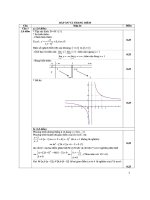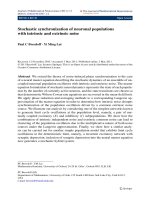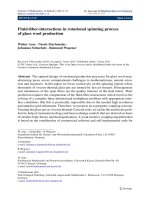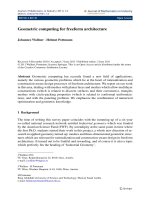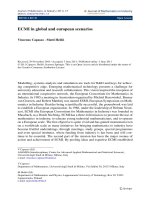BMJ volume 348 issue may23 1 2014 doi 10 1136%2fbmj g3284 ravi, b ; jenkinson, r ; austin, p c ; croxford, r ; wasserstei relation between surgeon volume and risk of complications after total hi
Bạn đang xem bản rút gọn của tài liệu. Xem và tải ngay bản đầy đủ của tài liệu tại đây (164.01 KB, 2 trang )
RESEARCH
bmj.com • Read the latest on orthopaedic and trauma surgery on our dedicated portal
Relation between surgeon volume and risk of complications after
total hip arthroplasty: propensity score matched cohort study
Bheeshma Ravi,1 Richard Jenkinson,1 Peter C Austin,2 3 Ruth Croxford,2 David Wasserstein,1
Benjamin Escott,1 J Michael Paterson,2 3 Hans Kreder,1 2 3 Gillian A Hawker2 3 4
Division of Orthopedic Surgery,
Department of Surgery, University of
Toronto, Toronto, ON, Canada
2
Institute for Clinical Evaluative
Sciences, Toronto, Canada
3
Institute of Health Policy,
Management and Evaluation,
University of Toronto, Toronto, ON,
Canada
4
Division of Rheumatology,
Department of Medicine, Women’s
College Hospital, Toronto, ON,
Canada
Correspondence to: B Ravi
Cite this as: BMJ 2014;348:g3284
doi: 10.1136/bmj.g3284
This is a summary of a paper that
was published on bmj.com as BMJ
2014;348:g3284
STUDY QUESTION
Is there a cut point in annual surgeon volume associated
with increased risk for complications after primary elective
total hip arthroplasty, and, if so, can we quantify this risk?
SUMMARY ANSWER
In a cohort of first time recipients of total hip arthroplasty,
we found that patients operated on by surgeons who had
performed 35 or fewer procedures in the year before the
index arthroplasty were at increased risk for dislocation and
early revision.
WHAT IS KNOWN AND WHAT THIS PAPER ADDS
Though there is a general consensus that increased surgeon
volume is associated with a reduced risk of complications,
there is a lack of consensus around what constitutes a
“low” annual volume. This study showed that in patients
undergoing total hip arthroplasty, the risks for dislocation
and early revision increased by about 48% and 44%,
respectively, when they were operated on by surgeons with
annual volumes ≤35 procedures.
Participants and setting
Patients in Ontario, Canada, who underwent a first primary
elective total hip arthroplasty during 2002-09.
Design, size, and duration
This was a propensity score matched cohort study. We
included 6716 patients who were operated on by a surgeon
who had carried out ≤35 such procedures in the 365 days
before the index surgery. We successfully matched each
(1:1) to a patient who received arthroplasty from a surgeon who had carried out more than 35 procedures in the
365 days before the surgery using a propensity score that
included several variables, including age, sex, comorbidity, various socioeconomic indicators, and hospital volume
(standardized difference <10% for all variables).
Main results and the role of chance
Patients with hip replacement carried out by a surgeon
with an annual volume of ≤35 procedures had a higher
rate of dislocation (1.9% v 1.3%; P=0.006) and revision
(1.5% v 1.0%; P=0.03) within two years of their surgery.
The numbers needed to harm for dislocation and revision
were 172 (95% confidence interval 164 to 182) and 204
(193 to 217), respectively. These recipients were at higher
risk of both dislocation (hazard ratio 1.48, 95% confidence
14
interval 1.21 to 1.80; P<0.001) and revision (1.44, 1.15 to
1.80; P=0.001) compared with those whose surgeons had
an annual volume of more than 35 procedures.
Bias, confounding, and other reasons for caution
We could not control for smoking or body mass index
(BMI). Both these factors, however, are strongly associated with other factors that were measured and balanced
between matched groups, including diabetes, hypertension, congestive heart failure, chronic obstructive pulmonary disease, chronic kidney disease, frailty, and various
socioeconomic indices.
Generalisability to other populations
The technique used here can be applied to various populations for any surgical procedure. Its use, however, requires
the availability of population based data, the ability to
accurately determine the volume for each operating surgeon in the year before the surgery, and specific patient
level data including comorbidity and sociodemographic
variables.
Study funding/potential competing interests
This study was supported by a grant from the Canadian
Institutes of Health Research and by the Institute for Clinical Evaluative Sciences, a non-profit research institute
funded by the Ontario Ministry of Health and Long-Term
Care. GAH is supported in part by the FM Hill Chair in Academic Women’s Medicine. ICES received support from the
Ministry of Health and Long-Term Care (CIHR Grant No:
MOP-15468).
Probability of specific complications v surgeon volume
Probability of compliance (%)
ЖЖEDITORIAL by Michaëlsson
1
4
3
Venous thromboembolism
Fracture
Infection
Revision
Dislocation
Death
2
1
0
0
20
40
60
80 100 120 140 160 180 200 220 240 260
Annual volume per surgeon
BMJ | 7 JUNE 2014 | VOLUME 348
Copyright of BMJ: British Medical Journal is the property of BMJ Publishing Group and its
content may not be copied or emailed to multiple sites or posted to a listserv without the
copyright holder's express written permission. However, users may print, download, or email
articles for individual use.

